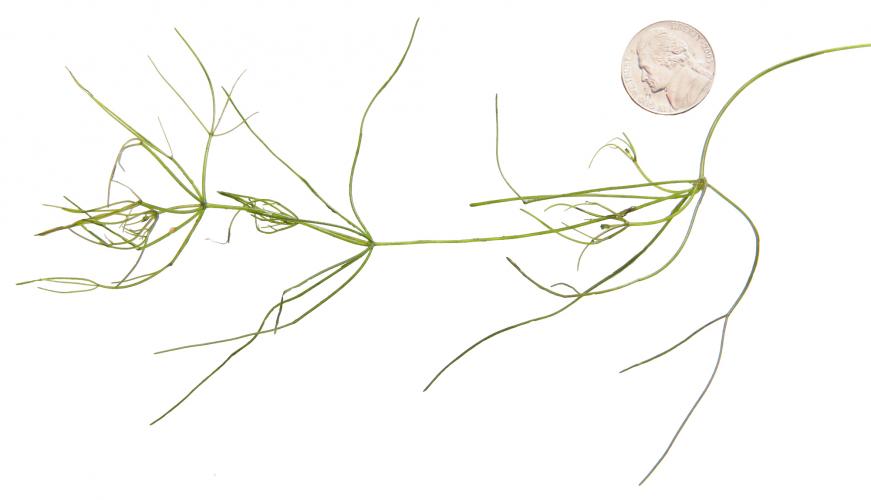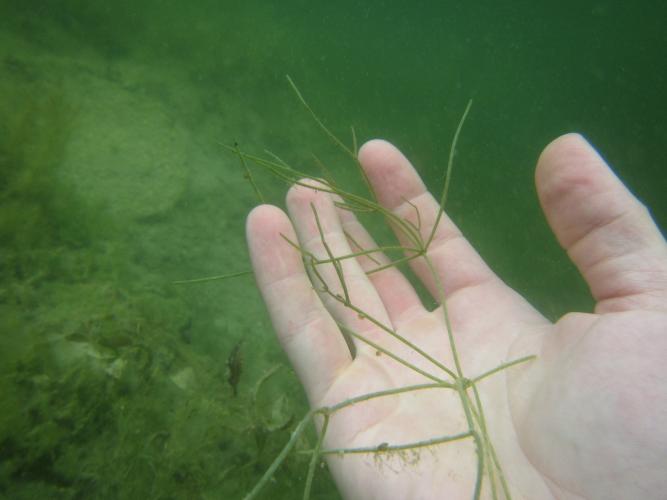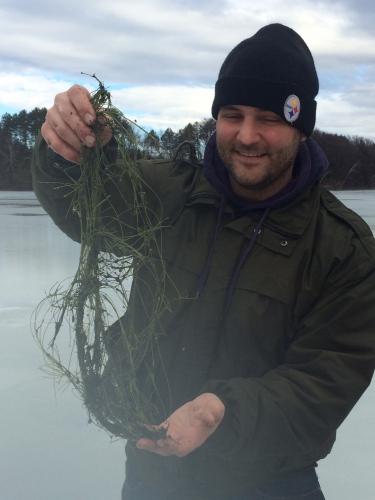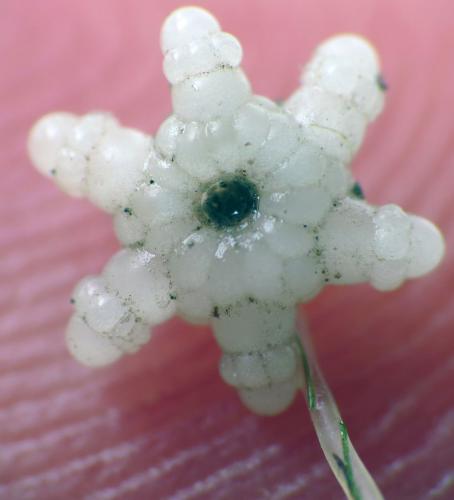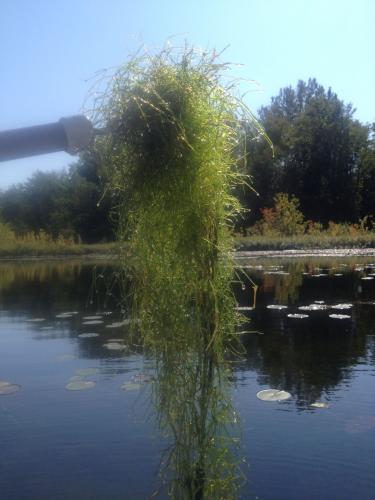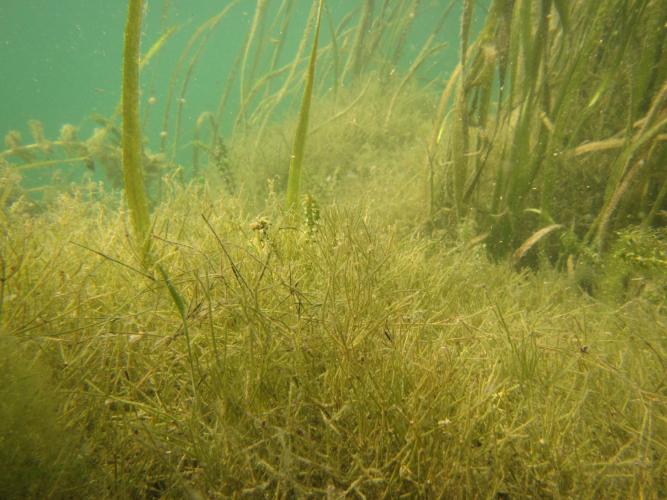Starry Stonewort
Identification
Nitellopsis obtusa is a grass-like macroalgae that is most easily identified by its white, 2-5 mm star shaped bulbils that are produced on clear threads called rhizoids. These bulbils can be found over the entire plant and throughout the year. If these bulbils are not present, N. obtusa can be identified by its uneven forking pattern, which is caused by the growth of short bracts from the branchlets. Common look-a-likes have branchlets that fork evenly. Branchlets are arranged in whorls of 5-8 with a large internodal space. Most stems and branchlets of starry stonewort are around 1 mm in diameter and the stem is smooth to the touch.
Biology
Origin
Starry Stonewort's native range extends from western Europe to Japan.
Habitat
Nitellopsis obtusa is typically found in slow moving shallow waters, but can be found at depths of up to 8 meters, often near docks and marinas. This species prefers waters that are relatively high in calcium and phosphorus.
LifeCycle
N. obtusa, in its native range, is an annual alga that dies off during the colder months of winter, sometimes persisting through milder winters. This species is dioecious and can reproduce sexually via its orange oospores, as well as asexually via the star-shaped bulbils. The oospores are thought to be a mode of dispersion as they can easily attach to the feathers or fur of animals.
Ecological Threat
Nitellopsis obtusa is able to grow rapidly and form dense mats that can cause a variety of problems. These dense, monospecific mats can be less than providing of suitable fish spawning habitat and can crowd out native plant species. If the mats reach the water’s surface, they can also hinder recreational use of the water body. Thick N. obtusa mats often act as benthic barriers and accumulate phytotoxins, making sediments inhospitable for rooted plant growth.
Vermont Distribution
Starry stonewort is currently found in Lake Memphremagog and Lake Derby, Vermont. Outside of the state, it is found in the Great Lakes and surrounding waterbodies.
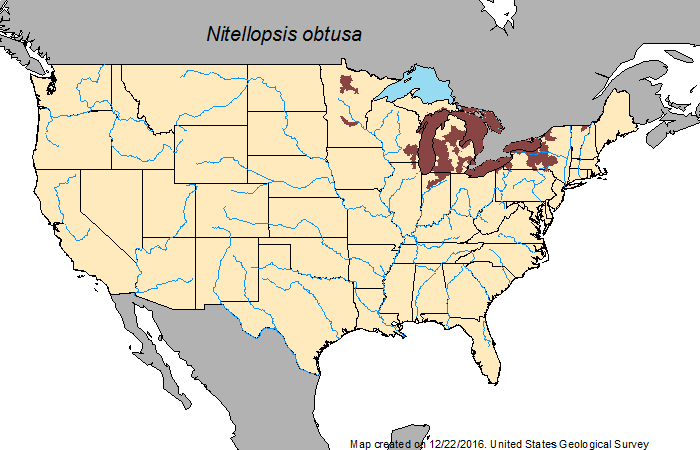
How You Can Help
For most aquatic invasive species, humans are the primary vector of transport from one waterbody to another. Many of these nuisance plants and animals can be unknowingly carried on fishing gear, boating equipment, or in very small amounts of water in a watercraft. The easiest and most effective means to ensure that you are not moving aquatic invasives is to make sure that your vessel, as well as all your gear, is drained, clean, and dry.
BEFORE MOVING BOATS BETWEEN WATERBODIES:
-
CLEAN off any mud, plants, and animals from boat, trailer, motor and other equipment. Discard removed material in a trash receptacle or on high, dry ground where there is no danger of them washing into any water body.
-
DRAIN all water from boat, boat engine, and other equipment away from the water.
-
DRY anything that comes into contact with the water. Drying boat, trailer, and equipment in the sun for at least five days is recommended. If this is not possible, then rinse your boat, trailer parts, and other equipment with hot, high-pressure water.
Interested in monitoring for aquatic invasives?
- Join the VIPs! Vermont Invasive Patrollers help search for new infestations so we can respond immediately and prevent them from becoming established.
For more information, check out this video from the Vermont Fish and Wildlife Department.
Citations
Bharathan S (1987) Bublils of some charophytes. Proceedings of the Indian Academy of Sciences 97:257–263.
Crawford G (2011) A new invasive in our midst: the starry stonewort saga. In: Michigan Inland Lakes Conference. Boyne Falls, MI, pp 1–44
Hackett RA, Caron JJ, and Monfils AK (2014) Status and Strategy for Starry Stonewort (Nitellopsis obtusa (N.A.Desvaux) J.Groves) Management. Michigan Department of Environmental Quality, Lansing, Michigan.
Kipp, R.M., M. McCarthy, A. Fusaro, and I.A. Pfingsten. 2016. Nitellopsis obtusa. USGS Nonindigenous Aquatic Species Database, Gainesville, FL. Revision Date: 6/21/2016
Mills, E.L., J.H. Leach, J.T. Carlton, and C.L. Secor. 1993. Exotic species in the Great Lakes: a history of biotic crises and anthropogenic introductions. Journal of Great Lakes Research 19(1): 1-54.
Pullman GD, Crawford G (2010) A decade of starry stonewort in Michigan. Lakeline 36–42.
Soulie-Marsche, I., M. Benammi, and P. Gemayel. 2002. Biogeography of living and fossil Nitellopsis (Charophyta) in relationship to new finds from Morocco. Journal of Biogeography 29(12): 1703-1711.
